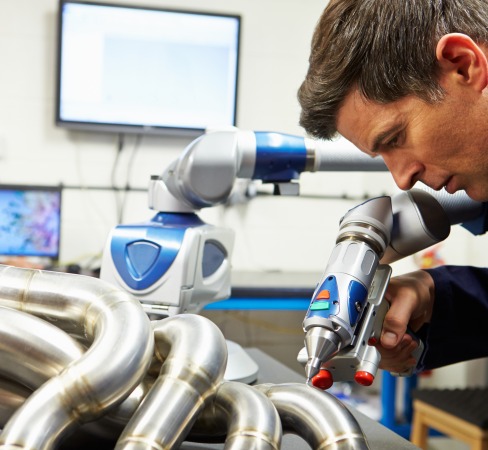Portable metrology equipment has seen a meteoric rise in its role supporting the various aspects of manufacturing over the past decade including reverse engineering, prototype part inspection, low volume production measurements, tooling and fixture inspection and alignment and the interrogation of product quality issues etc. One significant characteristic of portable metrology equipment is its ability to be used readily at the ‘point of manufacture’ allowing it to perform a reactive ‘walk-up and inspect’ role.
 With the coming of Smart Factories, driven by Industry 4.0, the critical role portable metrology equipment plays in manufacturing today often seems to get overlooked with all the talk of fully automated closed loop production. Portable metrology equipment, in the main, is manually operated so appears to be completely at odds with the predicted future of manufacturing with fully integrated metrology. Or is it?
With the coming of Smart Factories, driven by Industry 4.0, the critical role portable metrology equipment plays in manufacturing today often seems to get overlooked with all the talk of fully automated closed loop production. Portable metrology equipment, in the main, is manually operated so appears to be completely at odds with the predicted future of manufacturing with fully integrated metrology. Or is it?
While higher volume production products may get the ‘smart factory’ adaption will this really be the case for lower volume, specialized build, and larger physical products? Certainly some of the principles will carry over but these are more likely to be individual cell or processes/operation based rather than the complete production facility automated. The use of micrometers, vernier callipers and height gauges has not been eradicated by the part inspection automation driven by automatic coordinate measuring machines, and other similar devices, so why would portable metrology equipment be any different?
![]() The portable arm CMM (PCMM) remain the ‘go-to’ product for many inspection applications given its versatility, portability and robustness for shop-floor use. Originally developed as a manual CMM replacement, that negated the need to take parts to the lab for inspection, the PCMM has more recently transitioned its role and adapted to 3D laser scanning providing point cloud generation with full CAD analysis to its repertoire. The need for speed to verify during equipment set-up along with ongoing trouble-shooting of manufacturing quality issues will not be completely be eradicated by the ‘magic’ of the smart factory.
The portable arm CMM (PCMM) remain the ‘go-to’ product for many inspection applications given its versatility, portability and robustness for shop-floor use. Originally developed as a manual CMM replacement, that negated the need to take parts to the lab for inspection, the PCMM has more recently transitioned its role and adapted to 3D laser scanning providing point cloud generation with full CAD analysis to its repertoire. The need for speed to verify during equipment set-up along with ongoing trouble-shooting of manufacturing quality issues will not be completely be eradicated by the ‘magic’ of the smart factory.
 The role of the laser tracker, in large volume measurement, is mostly in supporting lower volume manufacturing and the alignment and inspection of tooling, fixtures and equipment. This role will certainly increase as smart factories are built and production equipment aligned to each other with increased precision.
The role of the laser tracker, in large volume measurement, is mostly in supporting lower volume manufacturing and the alignment and inspection of tooling, fixtures and equipment. This role will certainly increase as smart factories are built and production equipment aligned to each other with increased precision.
The generation of part surface geometry with point cloud software using hand-held and portable scanners has seen rapid growth over past years, with an ever increasing range of products coming to market. The ability to generate a digital twin, particular to support manufacturing processes where set-up requires numerous iterations and ‘tweaks’, will ensure that the role of these technologies will not diminish – and in all probability increase. In addition their role in reverse engineering, rapid prototyping and design development will also increase as product life cycles reduce and the number of product variants produced increase. (An Industry 4.0 prediction)
Will Portable Metrology Survive Industry 4.0?
Yes! Portable metrology will survive Industry 4.0 – and in all probability increase its role and presence on the manufacturing floors of the future. While the headline news concern the manufacturing revolution that is afoot the reality is that manufacturing, and its processes, will never be perfect and hence the role for portable metrology solutions will flourish. In addition we will witness further new portable products and technologies join the available solutions to control the manufacturing process albeit they will go about their role without making headline news.
Tags: 3d vina, hiệu chuẩn, hiệu chuẩn thiết bị, máy đo 2d, máy đo 3d, máy đo cmm, sửa máy đo 2d, sửa máy đo 3d, sửa máy đo cmm, Will Portable Metrology Survive Industry 4.0?
